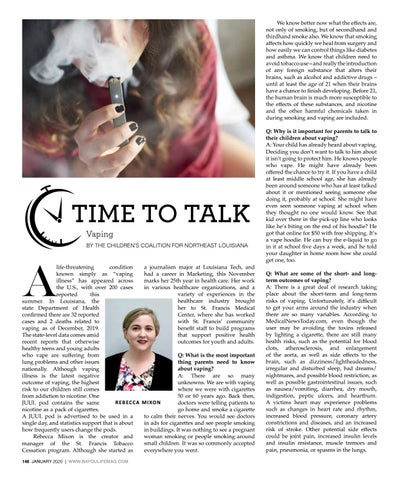We know better now what the effects are, not only of smoking, but of secondhand and thirdhand smoke also. We know that smoking affects how quickly we heal from surgery and how easily we can control things like diabetes and asthma. We know that children need to avoid tobacco use – and really the introduction of any foreign substance that alters their brains, such as alcohol and addictive drugs – until at least the age of 21 when their brains have a chance to finish developing. Before 21, the human brain is much more susceptible to the effects of these substances, and nicotine and the other harmful chemicals taken in during smoking and vaping are included.
Vaping
A
BY THE CHILDREN’S COALITION FOR NORTHEAST LOUISIANA
life-threatening condition known simply as “vaping illness” has appeared across the U.S., with over 200 cases reported this summer. In Louisiana, the state Department of Health confirmed there are 32 reported cases and 2 deaths related to vaping as of December, 2019. The state-level data comes amid recent reports that otherwise healthy teens and young adults who vape are suffering from lung problems and other issues nationally. Although vaping illness is the latest negative outcome of vaping, the highest risk to our children still comes from addiction to nicotine. One R E BEC C A JUUL pod contains the same nicotine as a pack of cigarettes. A JUUL pod is advertised to be used in a single day, and statistics support that is about how frequently users change the pods. Rebecca Mixon is the creator and manager of the St. Francis Tobacco Cessation program. Although she started as 146 JANUARY 2020 | WWW.BAYOULIFEMAG.COM
a journalism major at Louisiana Tech, and had a career in Marketing, this November marks her 25th year in health care. Her work in various healthcare organizations, and a variety of experiences in the healthcare industry brought her to St. Francis Medical Center, where she has worked with St. Francis’ community benefit staff to build programs that support positive health outcomes for youth and adults. Q: What is the most important thing parents need to know about vaping? A: There are so many unknowns. We are with vaping where we were with cigarettes 50 or 60 years ago. Back then, MI XO N doctors were telling patients to go home and smoke a cigarette to calm their nerves. You would see doctors in ads for cigarettes and see people smoking in buildings. It was nothing to see a pregnant woman smoking or people smoking around small children. It was so commonly accepted everywhere you went.
Q: Why is it important for parents to talk to their children about vaping? A: Your child has already heard about vaping. Deciding you don’t want to talk to him about it isn’t going to protect him. He knows people who vape. He might have already been offered the chance to try it. If you have a child at least middle school age, she has already been around someone who has at least talked about it or mentioned seeing someone else doing it, probably at school. She might have even seen someone vaping at school when they thought no one would know. See that kid over there in the pick-up line who looks like he’s biting on the end of his hoodie? He got that online for $50 with free shipping. It’s a vape hoodie. He can buy the e-liquid to go in it at school five days a week, and he told your daughter in home room how she could get one, too. Q: What are some of the short- and longterm outcomes of vaping? A: There is a great deal of research taking place about the short-term and long-term risks of vaping. Unfortunately, it’s difficult to get your arms around the industry when there are so many variables. According to MedicalNewsToday.com, even though the user may be avoiding the toxins released by lighting a cigarette, there are still many health risks, such as the potential for blood clots, atherosclerosis, and enlargement of the aorta, as well as side effects to the brain, such as dizziness/lightheadedness, irregular and disturbed sleep, bad dreams/ nightmares, and possible blood restriction, as well as possible gastrointestinal issues, such as nausea/vomiting, diarrhea, dry mouth, indigestion, peptic ulcers, and heartburn. A victims heart may experience problems such as changes in heart rate and rhythm, increased blood pressure, coronary artery constrictions and diseases, and an increased risk of stroke. Other potential side effects could be joint pain, increased insulin levels and insulin resistance, muscle tremors and pain, pneumonia, or spasms in the lungs.
